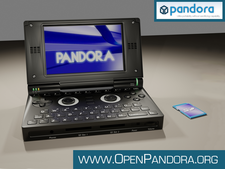Linux Pandora Box Goes into Mass Production
Around $330 gets you a Linux-based Pandora handheld by shopping online, although the first buyers had to hurry.
The Pandora looks like a Nintendo DS with a built-in keypad. It is the successor to the GP2X released around three years ago. The manufacturer, OpenPandora, hopes to produce 3,000 devices during this year -- assuming enough paid orders come in. Mass production should start 2009.
Visitors started besieging the OpenPandora website soon after the announcement and within six hours 2,000 orders had come in, bringing down the site for a short while. The forum was so overloaded that a temporary one had to be put in its place. The first batch of devices was orderable until Sunday, October 5 (even if they have to raise the batch to 4,000 units), and the first Pandoras should be entering the mail by end of November if all goes according to plan. The website will be updated on Tuesday with the final sales figures and the week after the very first of the mass production PCBs should be seen. The second batch orderable after October 5 should be available next year.

The diminutive Pandora handheld comes with an ARM Cortex-A8 CPU, 128MB active and 156 flash storage, and an OpenGL 2.0 ES-compliant PowerVR SGX 3D graphics processor. The 4.3" touchscreen LCD displays 800x480 pixels in 16 million colors. Input devices include the tiny gaming controls reminiscent of Gamepads and a 43-button QWERTY keyboard. Little treats include Wifi 802.11b/g, Bluetooth, a USB 2.0 port and an S-Video connection for TV output. The batteries should provide at least 10 hours of gaming pleasure. To see the Pandora in action, see the video on OpenPandora's Developer Blog page.
While all the possible tools for gamemakers are available for free on the developer wiki, older console emulators will probably keep the game supply coming, much as they did for the GP2X predecessor.